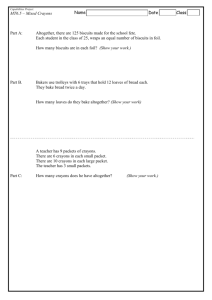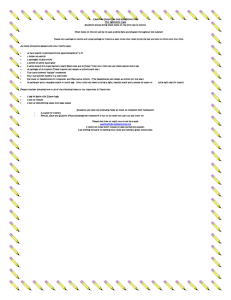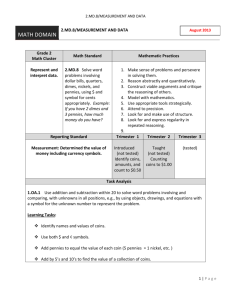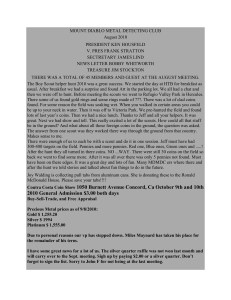BlissardProblemSolvingFile
advertisement
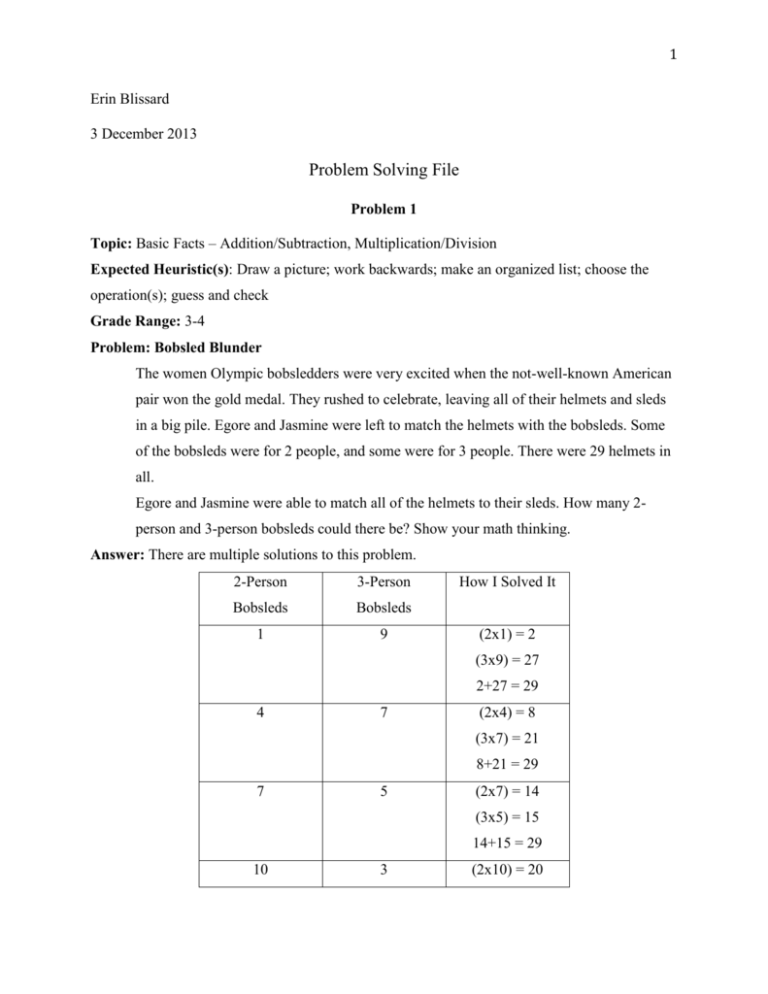
1 Erin Blissard 3 December 2013 Problem Solving File Problem 1 Topic: Basic Facts – Addition/Subtraction, Multiplication/Division Expected Heuristic(s): Draw a picture; work backwards; make an organized list; choose the operation(s); guess and check Grade Range: 3-4 Problem: Bobsled Blunder The women Olympic bobsledders were very excited when the not-well-known American pair won the gold medal. They rushed to celebrate, leaving all of their helmets and sleds in a big pile. Egore and Jasmine were left to match the helmets with the bobsleds. Some of the bobsleds were for 2 people, and some were for 3 people. There were 29 helmets in all. Egore and Jasmine were able to match all of the helmets to their sleds. How many 2person and 3-person bobsleds could there be? Show your math thinking. Answer: There are multiple solutions to this problem. 2-Person 3-Person Bobsleds Bobsleds 1 9 How I Solved It (2x1) = 2 (3x9) = 27 2+27 = 29 4 7 (2x4) = 8 (3x7) = 21 8+21 = 29 7 5 (2x7) = 14 (3x5) = 15 14+15 = 29 10 3 (2x10) = 20 2 (3x3) = 9 20+9 = 29 13 1 (2x13) = 26 (3x1) = 3 26+3 = 29 Possible Method of Solution: I think students in grades 3 or 4 will have difficulty recognizing the potential to use multiples of 2 and 3, and multiplication to find the solution; fifth graders may be more likely to recognize this, as they would be more familiar with multiplication. I think that kids would be likely to draw a picture of the bobsleds and the helmets to help them visualize the problem. It could look something like this with the individual bobsleds and the helmets/people: No matter which answer they arrived at, students could use their picture and see the total number of bobsleds, how many 2-person bobsleds there were, how many 2-person helmets there were, how many 3-person bobsleds there were, how many 3-person helmets there were, and the total number of helmets. Source: (2008). Exemplars [computer software/school subscription]. Available from http://www.exemplars.com/education-materials/math-k-12/math-k-8 3 Problem 2 Topic: Addition and Subtraction, Coins Expected Heuristic(s): Draw a picture, use manipulatives (coins), choose the operation(s), guess and check, counting on Grade Range: 1-2 Problem: Doris has 2 quarters, 1 dime, and 4 pennies. She wants to buy the toy frog which costs 79¢. What other coins does she need to buy the frog? Answer: Doris has 64¢ to begin with (2 quarters = 50¢; 1 dime = 10¢; 4 pennies = 4¢). Because of how much money Doris has and how much she needs there can be multiple solutions to the problem. She needs 15¢ more in order to buy her toy, and there can be several possibilities. Number of Different Coins 15 pennies 10 pennies; 1 nickel 5 pennies; 2 nickels 5 pennies; 1 dime 1 nickel; 1 dime 3 nickels Total Value of Coins 15¢ 15¢ 15¢ 15¢ 15¢ 15¢ Possible Method of Solution: My favorite method of solution would be to actually give students the coins. Of course, the teacher would have to know whether they knew the denominations/worth of each coin so that students actually understood how to use them. After receiving the coins, I would model how many coins Doris has – setting aside 2 quarters, 1 dime, and 4 pennies. I would figure out how much money that is in total, by adding or counting on, and arriving at 64¢. Q= 25 Q= 25 D= 10 P=1 P=1 P=1 P=1 4 Then students could use more coins, starting a new group to figure out how many coins are in 79¢. The 79¢ could be modeled using quarters, or not, so students would need to recognize that they there are different combinations of coins that could be used and they would still be equivalent (ex. 1 quarter = 2 dimes, 1 nickel). So I’m going to start again with what Doris has, and then add coins until they have 79¢, the cost of the frog. Q= 25 D= 10 Q= 25 D= 10 P=1 P=1 P=1 P=1 N=5 Students can then compare the two piles, removing the basic 64¢ that Doris began with, and whatever coins are remaining (any of the possible combinations of 15¢) are the solution to the problem. Source: Houghton Mifflin (n.d.). Problem Solving 14.7. Retrieved from http://www.eduplace.com/math/mw/practice/1/problems/14_7.pdf 5 Problem 3 Topic: Computation; multiplication Expected Heuristic(s): Draw it; Choose operations and complete; work backwards; make organized list Grade Range: 3-4 Problem: Calling All Students Mrs. Forest wanted to plan how to contact her students by phone in case the field trip they were going on the next day needed to be cancelled. She decided to call 1 student who would then call 2 other students. Each of these students would then call 2 other students. This would continue until all students had been called. Mrs. Forest has 31 students. How many students will need to make phone calls if Mrs. Forest calls the 1st student? Answer: 15 students will make phone calls Possible Method of Solution: See attached paper Source: (2008). Exemplars [computer software/school subscription]. Available from http://www.exemplars.com/education-materials/math-k-12/math-k-8 6 Problem 4 Topic: Basic Facts - Money Expected Heuristic: Draw it, charts, use manipulative money, make a systematic list, work backwards Grade Range: 2-4 Problem: Candy Shop Treats Ms. Krejcarek was very excited because she was going to the candy shop to buy candy for a party. The sign in the shop window read: Candy Shop Reese’s Peanut Butter Cups ……………… 1 penny Twix ……………………………………… 1 nickel Kit Kats…………………………………… 1 dime Hershey Bars……………………………… 1 quarter Ms. Krejcarek had 28 cents in her purse. She did not know what to buy because she liked everything in the shop! Help Ms. Krejcarek by giving her ideas about what to buy at the candy shop so that she will spend all 28 cents. Answer: There are multiple solutions to this problem, and they depend on how the children interpret the 28 cents that Ms. K has to spend. Here are some possible solutions: How much money Ms. K has 28 pennies = 28 cents 1 nickel + 23 pennies = 28 cents 2 nickels + 18 pennies = 28 cents 3 nickels + 13 pennies = 28 cents 1 dime + 1 nickel + 13 pennies = 28 cents 1 dime + 2 nickels + 8 pennies = 28 cents 1 dime + 3 nickels + 3 pennies = 28 cents 2 dimes + 1 nickel + 3 pennies = 28 cents 2 dimes + 8 pennies = 28 cents 1 quarter + 3 pennies = 28 cents 5 nickels + 3 pennies = 28 cents What she can buy 28 Reese’s cups 1 Twix, 23 Reese’s cups 2 Twix, 18 Reese’s cups 3 Twix, 13 Reese’s cups 1 Kit Kats, 1 Twix, 13 Reese’s 1 Kit Kats, 2 Twix, 8 Reese’s 1 Kit Kats, 3 Twix, 3 Reese’s 2 Kit Kats, 1 Twix, 3 Reese’s 2 Kit Kats, 8 Reese’s 1 Hershey Bar, 3 Reese’s 5 Twix, 3 Reese’s 7 1 dime + 18 pennies = 28 cents 1 Kit Kats, 18 Reese’s Possible Method of Solution: Students could make a chart similar to the one above Source: Created by Ms. Krejcarek, Vice Principal of Magruder Elementary, for October exemplars. Problem Reflection: I taught this problem to my fourth grade class on October 25th. Like the other math Exemplars they do every Friday, I introduced this problem in a similar way. I read the problem aloud to the class and then we found the important or useful information in the problem; this is how every Exemplar is introduced. Because this is an odd problem, and probably something that would not occur in real life, I made it clear that students had to use a particular coin in order to get a particular candy; for example, I told students that if they wanted to buy a Hershey Bar they would have to use one quarter, and that they could not use 5 nickels or any other combination that would equal 25 cents. Because I made this explicit, it did not pose any problem while students were solving the problem. This problem had many possible solutions, so I asked students to find at least four, if not more; this provided multiple levels of difficulty for students with differing needs and abilities. Students worked in small groups of their choosing, and one student chose to work independently. The strategies that students used varied; some students made charts and lists that showed money and candy and others just had pages of equations with the coin values adding up to 28 cents. The gifted students did not have a problem getting started and finding multiple solutions; one student found 13 possible solutions. The average students also did well, finding more than the four solutions. These students did not have problems only using particular coins and knowing that certain coins could buy certain candies. The lower performing students were not having as much luck coming up with the minimum four solutions when using lists and charts, because I think it was hard for them to think of money and coins only on paper, so I pulled out coin manipulatives. With the coin manipulatives and being able to physically manipulate the coins and see the many combinations of 28 cents they were better able to solve the problem and find more than four solutions. One student, even with the manipulatives, still had problems with the concept of money; this makes me think back to what Mr. Shippee said in class about students not having experience with actual money, and how everything is digital and plastic, which just 8 goes to show how important it is that students have math lessons and experiences that deal with cash. Aside from the unrealistic nature of the problem, where a store will only accept particular coins for particular items, I think it is useful in getting students to think about how different combinations of coins and bills can equal the same sum of money. I think this problem is suitable for students of many abilities because there are multiple strategies that can be used and multiple solutions. If the problem is adjusted to be more realistic – like being in a shop to purchase certain items and having a certain amount of money, like $20.00 and then getting back change in various forms. 9 Problem 5 Topic: Geometry Expected Heuristic: draw it, model it, guess and check Grade Range: 4-5 Problem: Mrs. Garvey’s bathroom measures 6 feet by 10 feet. She wants to cover the floor with square tiles. The sides of the tiles are 6 inches. How many tiles will Mrs. Garvey need? Answer: Mrs. Garvey will need 240 tiles. For the length of the floor she will need 12 tiles, and for the width of the floor she will need 20 tiles (1 foot = 12 inches = 2 tiles). Then 12x20 = 240 tiles. Possible Method of Solution: Draw It Out. Students can create a rectangle, labeled with the appropriate measurements and then fill it in with the correct number of tiles (knowing that 1 foot = 12 inches = 2 tiles). Source: (2013). Word problem database: Geometry word problems level 1. Math Playground. Retrieved October 28, 2013 from: http://www.mathplayground.com/wpdatabase/Geometry1_3.htm. 10 Problem 6 Topic: Basic Facts: Counting, Patterns; Computation: Addition, Multiplication Expected Heuristic(s): Draw it; choose operations and complete; make a list; make a chart Grade Range: 2-4 Problem: Batting Practice Jessica love to play baseball and was determined to improve her batting average. She decided to make a practice schedule for her summer vacation. On the 1st day of her vacation she will practice until she hits the baseball 3 times. On the 2nd day she will practice until she hits the baseball 5 times. On the 3rd day she will practice until she hits the baseball 7 times. On the 4th day she will practice until she hits the baseball 9 times. If Jessica continues with this practice schedule, how many times will she have to hit the baseball on the 10th day? The 40th day? Show your work and explain your reasoning. Answer: On the 10th day Jessica will hit the baseball 21 times. On the 40th day Jessica will hit the baseball 81 times. Possible Method of Solution: Make the schedule like Jessica would. Day 1 2 3 4 5 6 7 8 9 10 40 Hitting the Ball 3 5 7 9 11 13 15 17 19 21 81 In making the chart students may notice the patterns that evolve: each day Jessica will hit the ball two more times than she did the previous day (so each day you add 2 to the previous number of hits). Another pattern that evolves is to double what day it is and then add one to get how many times Jessica would hit the ball: so day 8 is [8+8+1=17], day 40 will be [40+40+1]; in doing this doubling and adding students may also use multiplication ([40x2]+1 =81). I think if students 11 don’t pick up on these patterns the work to solve to day 40 will be very time consuming and tedious. Source: (2008). Examplars [computer software/school subscription]. Available from http://www.exemplars.com/education-materials/math-k-12/math-k-8 Problem 6 Reflection: I taught this problem to my fourth grade class on November 8, 2013. Like the other Exemplars (problems) that students do every Friday, we went over the problem as a class and highlighted the important information. Then I asked the students what were some different strategies they could use to figure it out; some students immediately said making a chart and other students gave suggestions like making lists or drawing it. The majority of students made charts, and the rest made lists or wrote out many operations. Students began the problem by looking at the information they had, and using it to find the rest of the information needed. I went around to observe and assist students as they worked in small groups, or by themselves (which some preferred). Most students did not have trouble using the given information to find the initial pattern of practicing and figure out how many times Jessica practiced on day 10 (each day Jessica hits the ball two more times than the previous day). The students that did have trouble using the given information and finding the pattern were a few students with special needs and IEPs. I noticed that these students either worked with other students and copied the answers from them, or they would get frustrated and shut down. When students had to solve for how many times Jessica practiced on the 40th day, some students detected the second pattern between the day and the number of times she practiced, and some students actually used the initial pattern they used all the way up to the 40th day. The students that had found a pattern between the day and the number of times practiced had patterns very similar to the “possible method of solution” that I had used. Students were given the chance to present their strategies and solutions to the class; 3 groups and 2 individuals presented. I thought this problem successfully met the needs of many students. It was challenging for the inclusion students and some average math students in the class. It also allowed the gifted students to solve for further days; I had some students figure out how much she would practice on the 50th day, the 100th day, the 150th day. 12 In the future I don’t think I would modify the problem itself, but how it is presented to the class and how students work on it with one another. Because some students still seemed confused about what the problem was even asking them to do, I think I would be more explicit about what the problem is asking the students to do, maybe even writing it out – “Using the given information, you will figure out how many times Jessica will practice on the 10th day, and etc.” I think it would benefit the students with special needs to work with concrete objects to help model the problem; I realize this would get difficult when the numbers get bigger, but I think it may be less frustrating then simply using pen and paper. To help students get the most from the problem, and not simply copy the answer from their peers, I think I would have students work individually. In doing this, I think it would give the teacher a better assessment of their individual knowledge and understanding. 13 Problem 7 Topic: Counting and Basic Facts Expected Heuristic: Draw a picture, make a list, guess and check Grade Range: 1-2 Problem: Counting Crayons Margie is counting crayons in her classroom. There are complete boxes of crayons, with 10 crayons in each box. There are also crayons that are not in boxes. There are 3 boxes of red crayons and 15 more red crayons that are not in boxes. There is 1 more box of blue crayons than red crayons. There are 12 blue crayons not in boxes. There is 1 less box of green crayons than red crayons. There are no green crayons left over. The rest of the crayons are yellow. How many crayons of each color are there? Answer: Color Red Crayons Blue Crayons Green Crayons Yellow Crayons Number of Crayons 45 (10+10+10+15) 52 (10+10+10+10+12) 20 (10+10) 13 (10+3) Possible Method of Solution: I think younger students would benefit from drawing the crayons out and coloring them the appropriate colors. That will help them visualize the question and the solution. The squares represent boxes of 10 crayons, and the lines represent one crayon. Red Crayons: Blue Crayons: 14 Green Crayons: Yellow Crayons: Source: Houghton Mifflin (n.d.). Brain Teasers: Grade 2, Unit 2 Question. Retrieved from http://www.eduplace.com/kids/hmm/bt/2/2_02-1q.html 15 Problem 8 Topic: Number Sense and Computation Expected Heuristics: Draw a picture, make a list, make a chart, choose operations and complete Grade Range: 3-4 Problem: Help, I’m Melting! The students in Mrs. McNair’s class stacked 31 ice cubes near the window at 8:05 in the morning. The sun came out and melted 1 ice cube the 1st hour. It melted 2 ice cubes the 2nd hour and 4 ice cubes the 3rd hour. If this pattern continues, at what time will all the ice cubes have melted? Answer: All ice cubes will have melted by 1:05 pm. Possible Method of Solution: To solve this problem I created a chart with the information given, detected a doubling pattern for how many cubes melted each hour, and filled in the rest of the chart until there were no ice cubes left. Hour Time Ice cubes melted Ice cubes left 0 8:05 am 0 31 1 9:05 am 1 30 2 10:05 am 2 28 3 11:05 am 4 24 4 12:05 pm 8 16 5 1:05 pm 16 0 Source: (2008). Examplars [computer software/school subscription]. Available from http://www.exemplars.com/education-materials/math-k-12/math-k-8 Problem 8 Reflection: I taught this problem to my fourth grade class on December 2nd. I introduced the problem by reading it aloud and having the students find the important information needed to answer the question. This is the routine with all math Exemplars that the students do. After they had found all the important information I asked what strategies they thought they might use for this problem, some students said to make a chart or a table, one 16 student said to draw it, and others said to do a big subtraction problem. After that I let students get started. Within the first five minutes of having them work on the problem individually, it was clear that students were not really understanding what the problem was asking them to do and how they should go about solving it. Seeing this, I let students work with the people seated near them at their desks. Still, many students were asking me for help and while I tried to explain what the problem was asking them to do they still couldn’t understand it. To make the problem more clear, I got back up in front of the class and explained the scenario by sort of acting it out, so students could picture the situation. I essentially said: “You have 31 ice cubes and you stack them all up by the window at 8:05 am. Then the sun comes out and melts more and more ice cubes, in a specific pattern, until there is none left. We have to figure out the pattern of how many ice cubes are melting each hour, so we can figure out when there will be zero ice cubes left and figure out what time it was.” Because students were still having problems getting started, I created the chart you see above, putting the specific headings and the given information in the problem, and explained that charts worked best for me but you could solve the problem using many other strategies; then I let the students continue working. After this some students copied the chart on the board, some students created variations of the chart, and some continued to do use computation (subtraction). The majority of the students in the class were able to pick it up pretty quickly, but others were unable to identify the pattern, which was doubling. Many students thought the pattern used addition, which led them to an incorrect answer. I worked with one student in particular who could not identify the patter, even after I explained what a pattern was and even after we had gone over the given information (1x2 =2, 2x2=4, so 4x__ = ? will be the next number). Overall most of the students had gotten the final answer, through working with friends and me pointing out where they may have gone wrong. I thought this problem should have been pretty easy for 4th graders, and more of an exercise, but because they haven’t worked with or reviewed patterns recently they had more difficulty detecting a pattern. I think if the given information had contained one more hour of data (and had a larger number of ice cubes) then the pattern could have been more clear to the students, and there would have been less confusion about what the pattern was. This problem would work well for younger grades learning about patterns and time, or it could be a good review for the upper grades to review the concepts of patterns and time.

